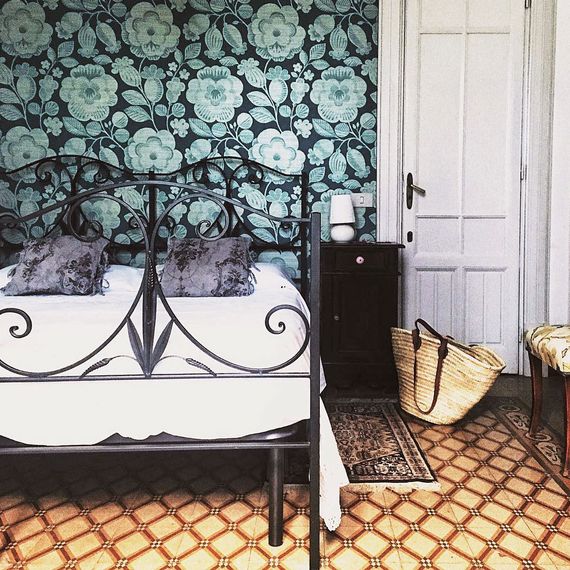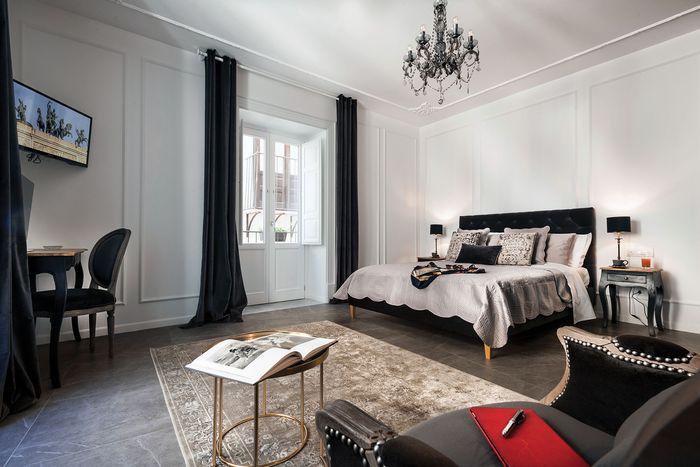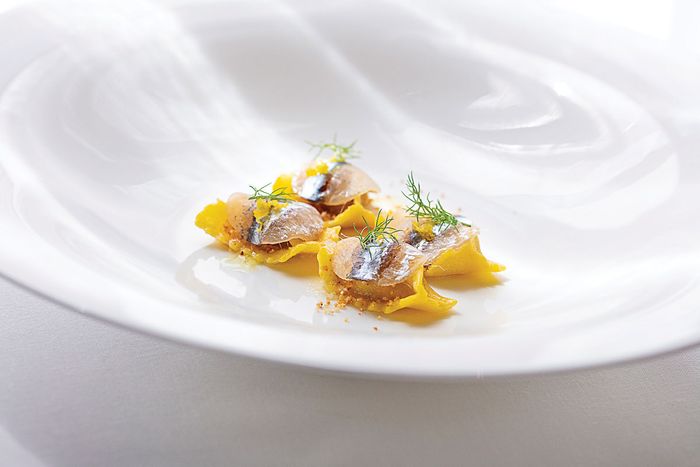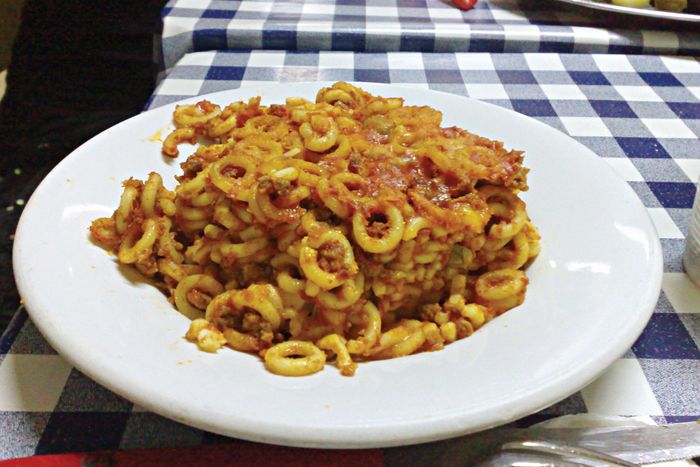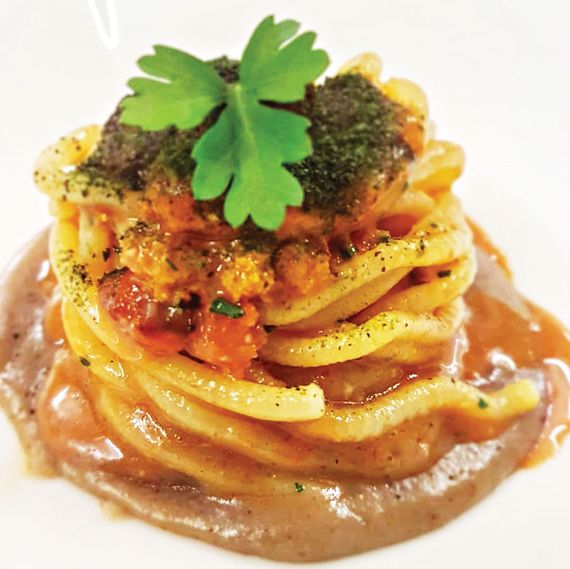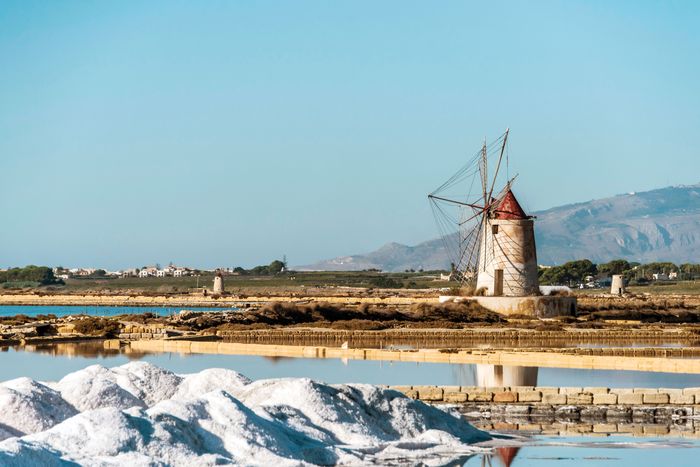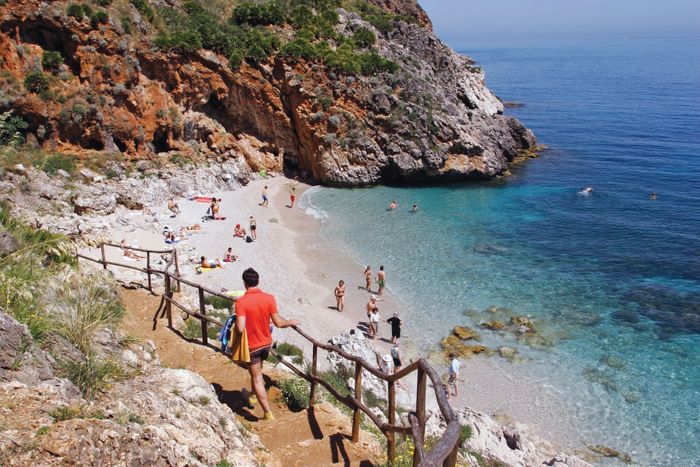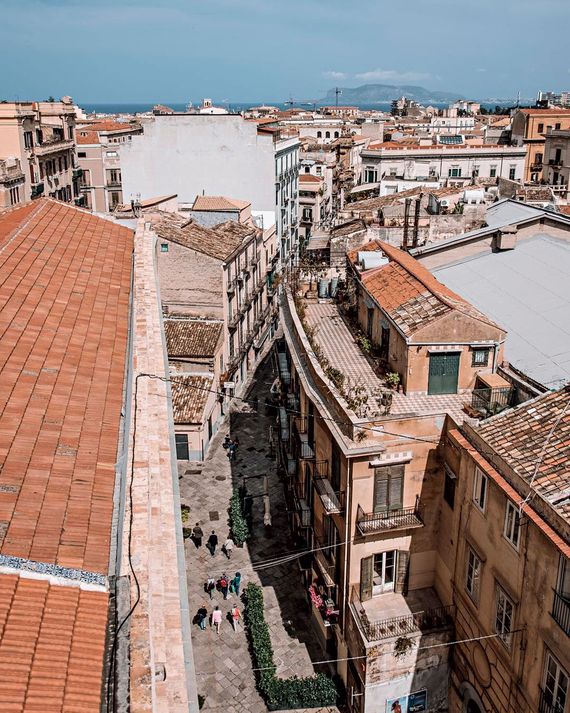
Until fairly recently, tourists treated the somewhat crumbling seaside city of Palermo as a mere touchdown between other Sicilian destinations: the volcanic Aeolian Islands; the coastal, cobblestoned city of Cefalù; the Greek temples of Agrigento. Spend a night there and get out as quickly as you can. But now they’re deciding to stay a while. The Italian government selected the city as its capital of culture for 2018, and the same year Palermo hosted the Manifesta art festival, boosting its tourist numbers by 10 percent. Meanwhile, the Mafia’s stultifying grip on the city has continued to loosen in the wake of the collective outrage over the murders of judges Paolo Borsellino and Giovanni Falcone in 1992. The organization no longer controls local politics and law enforcement and has mostly ceded the drug trade to criminal organizations beyond Sicily. Having regained a measure of control over their city, residents are clearly in a positive mood, evidenced by the revved-up social scene in the old center of town: Where once a chaos of traffic reigned, the left-wing mayor, Leoluca Orlando, has restored the salotto urbano — the “urban living room” — with numerous pedestrian-friendly initiatives. In Palermo, the ancient (Greek, Roman) mingles with other traces of past settlements (Byzantine, Norman, Arab, Swabian, French, Spanish) in its architecture, in the Sicilian dialect, and in its traditional dishes, renowned street food, and centuries-old food markets. But sidling up to the city’s fusty dining and hotel options are palazzos now filled with contemporary art and rehabbed hardware stores turned bars.
1. A Faded-Grandeur Guide
The city is full of buildings that look like they could use a good power-wash, but that’s the charm. Claudio Gulli, the historian of art venue Palazzo Butera, on his city’s unmissable relics.
The Botanical Garden
“The Orto Botanico [botanical garden] perfectly encapsulates the spirit of Palermo — plants from all over the world were once acclimated here before being sent all over Europe. It was imagined by a Jacobin Frenchman, Léon Dufourny, who came to study Greek architecture in Sicily in the late 1700s, as many architects did. Once you pass through the templelike neoclassical welcome building, you can stroll through greenhouses filled with impossibly lush vegetation, wander through the palm garden dotted with carved marble figures, and marvel at the enormous drooping limbs of the Australian banyan tree here.”
The Trio of Baroque Churches
“To understand Sicilian Baroque, there are three churches along Via Torremuzza in the historical quarter of Kalsa — Santa Teresa Alla Kalsa, Santa Maria Della Pietà, and the Noviziato dei Crociferi. They’re all from the end of the 1600s, early 1700s, and each has its own distinctive façades including articulated windows and double rows of columns. Today, they seem a bit neglected, but they were incredibly important structures, and the designs for the frescoes of the Pietà are in the Louvre.”
The Frescoed Palazzo
“In Piazza Marina, the 14th-century Palazzo Steri of the Chiaramonte family defined Gothic architecture in Sicily: Its notable windows in black-and-white stone became known as ‘Chiaramonte Gothic.’ The University of Palermo is restoring the intricately painted wooden ceiling, a masterpiece of Gothic decoration from the 1370s and 1380s that will be unveiled in a few months. You can tour through the Inquisition Museum inside, where you can still see the drawings prisoners made on the walls.”
The Roofless Church
“The unfinished 16th-century Spasimo church, which was supposed to contain a painting by Raphael (now in the Prado), has no roof and is one of the most evocative open-air churches in Italy. It’s located right in the center of Palermo, and on summer nights there are popular film festivals, theater performances, and jazz concerts on the grounds.”
2. How the Art Crowd Hangs Out
Days at Baroque palazzos, nights at former hardware stores.
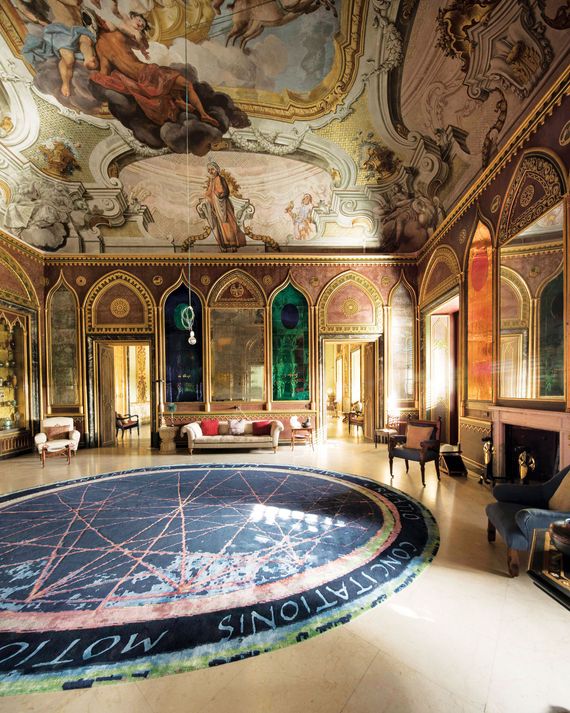
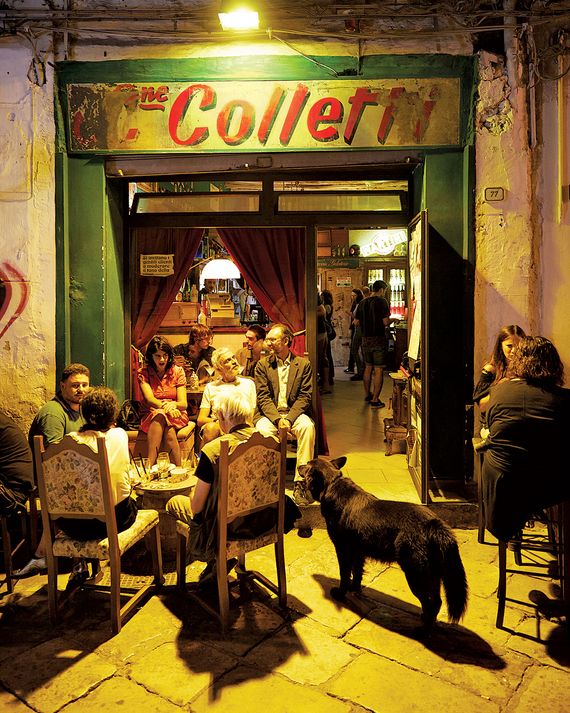
Daytime Art Spots
“Massimo Valsecchi, one of Europe’s most prominent art collectors, bought Palazzo Butera (Via Butera 18) to exhibit his collection (which includes works by Gerhard Richter and Gilbert & George, plus site-specific pieces by Anne and Patrick Poirier) to the public.”—Andrea Masu, artist in the Alterazioni collective
“The Riso museum (Via Vittorio Emanuele 365), located inside a restored Baroque palazzo, has had shows from contemporary Italian artists like Giuseppe Veneziano. It’s in the pedestrianized part of the city, where everyone is out walking these days.” —Francesca Borghese, co-founder of cultural-event series Cogito
“The once-industrial area of Cantieri Culturali alla Zisa has film festivals and photo shows, and it’s home to ZAC (Via Paolo Gili 4), the center for contemporary art — now a magnet for local creatives. After events, people hang and drink beer.” —Claudio Gulli, Palazzo Butera art historian
“At the Galleria d’Arte Moderna (Via Sant’Anna 21), there’s a collection of art from the 1800s until the 1950s. They show contemporary exhibitions inside a part of the complex that’s a beautiful old Franciscan convent.” —Francesco Pantaleone, founder of Francesco Pantaleone Arte Contemporanea
Nighttime Drink Spots
“Bocum (Via dei Cassari 6) in the old city center has a talented bartender who makes a divine gin-and-tonic, but what I love best is the surreal atmosphere of the place— there’s a piano and chandeliers and mismatched stuffed armchairs — as if you’re in a Palermo of the past.” —Borghese
“Or I’ll I head to Le Cattive (Passeggiata delle Cattive, Piazza Santo Spirito), a wine bar inside Palazzo Butera with a cavernous space that’s very antique feeling: tiled floors, pistachio-colored walls, but mixed with sleek pendant lighting.” —Borghese
“And I love to go to Ferramenta (Piazza Giovanni Meli 8). It was a hardware store that opened in the 1800s; today, the bar still has all the old little drawers where they used to store their tools and parts. I’m half-German, so I like to drink beer there, but at least it’s Sicilian beer.” —Pantaleone
“In Palermo, so much of life happens on the street, particularly on Via Paternostro. A lot of artists, musicians, and creative people in town hang out at Botteghe Colletti (Via Alessandro Paternostro 79), a bar in a 1940s-era collar store. Their Campari cocktail with Sicilian herbs is amazing.” —Edoardo Dionea Cicconi, artist and musician
3. Want to Get a Palermitan Talking?
Broach one of these hot topics.
The Mafia in Decline
More than 20 years ago, a rebellion against the Mafia’s stranglehold produced grassroots movements like Addiopizzo, which united over 1,000 establishments in their refusal to pay the pizzo, or bribe. While the movement took a while to gain traction, one-third fewer Sicilian businesses now pay the pizzo than in the ’90s. The Mafia still has a presence in the city,
but it’s been weakened enough so that residents and businesses are able to thrive.
The Immigrant-Friendly Mayor
Recent elections put anti-immigrant nationalists at the center of Italian politics, but this has only strengthened the city’s resolve to welcome foreigners. Mayor Leoluca Orlando has rejected the xenophobic proposals put forth by the Lega party’s nationalist leader, Matteo Salvini, defying his call for closed borders by inviting rescued migrant boats to dock in Palermo.
The Tourists
As protests over massive levels of tourism roil Venice and Florence, some Palermo residents wonder if their influx — there were almost 1.3 million tourist visits in 2017 — might degrade the city’s authenticity (its historic markets already seem to be losing theirs). As one local said, “We just go to the market at night to drink cheap beers. Eating at the markets is for tourists now.”
4. Where the Local Travel Guides Would Stay
If they weren’t locals.
$
Olivella Bed & Breakfast
olivellabb.it, from $50
“This homey five-room B&B that’s housed in a former silver factory manages to feel modern while also maintaining a lot of original details, like heirloom bed frames, tiled floors, and frescoed ceilings. Plus it’s very central, located right by Teatro Massimo.” —Edoardo Zaffuto, Addiopizzo Travel founder
$ $
Piazza Borsa
piazzaborsa.it, from $125
“Yes, there’s the five-star Villa Igeia, but it’s far from the center. Piazza Borsa is four stars; it’s right by Quattro Canti and in the erstwhile 19th-century stock-exchange building, which has a courtyard and a fountain.” —Domenico Aronica, Palermo Walking Tour
$ $
Palazzo Natoli
palazzonatoli.com, from $175
“Palermo’s weak spot is its luxury-hotel offerings, but there are small boutique hotels opening to fill the gap, like the lovely Palazzo Natoli, which opened in 2018 inside a Baroque townhouse. Its eight rooms are plushily modern with chandeliers and gilded mirrors, and it has its own small bistro offering dishes with locally grown and organic ingredients.” —Marcella Amato, the Best of Palermo travel guide
5. Order Pasta Like a Palermitan Chef …
Classic and newfangled iterations of the city’s essential dishes.
The Dish: Pasta c’anciova
Pasta with anchovies, tomato sauce, raisins, pine nuts, and toasted bread crumbs.
The Traditional Version
The Corona family has decades in the local restaurant world and opened Corona Trattoria (Via Guglielmo Marconi 9) four years ago. According to Sarah Bonsangue, chef at I Cucci (Piazza Bologni 3/4), “The team respects classic methods and uses quality ingredients,” and serves them alongside an entirely Sicilian wine list.
The New-School Interpretation
“My teacher, Tony Lo Coco, at I Pupi (Via del Cavaliere 59, Bagheria),” a Michelin-starred restaurant in a tiny town about a half-hour beyond Palermo, “makes a ‘liquid anchovy’ version with bread crumbs.”
The Dish: Timballo di anelletti
Pasta rings baked in a ragù with prosciutto and cheese.
The Traditional Version
Run by two brothers, the red-checked-tablecloth Trattoria Ai Cascinari (Via D’Ossuna 43/45) is known for its home-cooking feel. “It reminds me of growing up, waking to the scent of ragù,” says Patrizia di Benedetto, chef at Bye Bye Blues (Via del Garofalo 23).
The New-School Interpretation
If you call the day before, the folks at Badalamenti (Viale Galatea 55), a restaurant in the Mondello neighborhood, will make you anoff-menu timballo with fresh pork, salami, and real tomato extract, “as it used to be done in Sicilian households back in the day.”
The Dish: Pasta con i ricci
Pasta with sea urchin.
The Traditional Version
At Spanò (Via degli Scalini 6), a bare-bones restaurant with tables in the parking lot, service is notoriously horrendous, yet the excellent seafood turns diners into faithful customers. “The freshness of the fish makes all the difference, and their version is a must,” says Vladimiro Farina, chef at Ristorante L’Ottava Nota (Via Butera 55).
The New-School Interpretation
A minimalist setting, with white brick and gray wood, that mixes tweaked Palermitan cooking with local spices. “Chef Vincenzo Pinto’s seaweed version at A’Cuncuma (Via Judica 21) is incredible.”
… And Get Pistachio Granita in Kalsa
Palermo’s cuisine particularly shines when it comes to the most humble street-food specialties. Orazio Corona, who runs the Corona Trattoria seafood restaurant with his parents, maps the out the best snacks in the historic center.
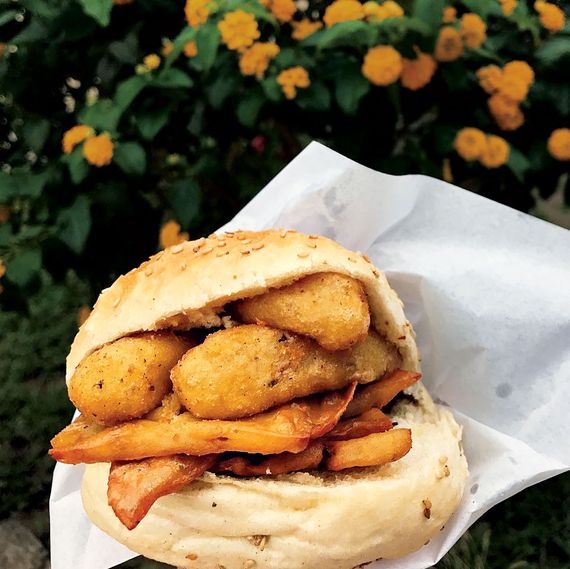
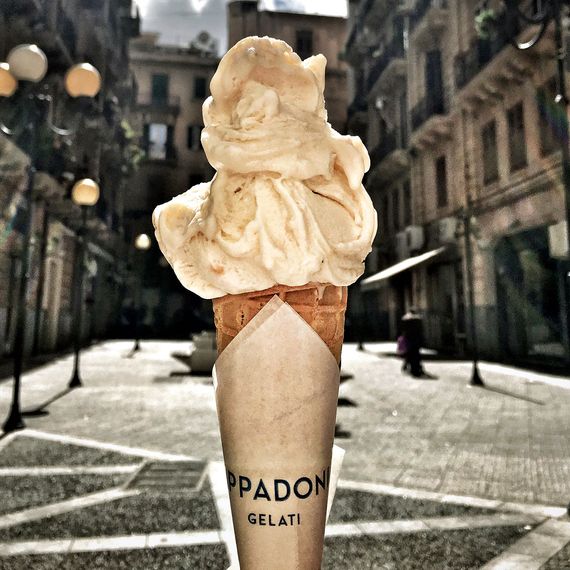
First Stop
Panineria Friggitoria Chiluzzo
Piazza Della Kalsa 7
“It’s very simple here — just a stand on the street — but they serve fantastic babbaluci, small snails with parsley, that locals love to eat, especially when threre’s a parade around July 15 for the festival of Santa Rosalia.”
Second Stop
Pani Ca’ Meusa Porta Carbone
Via Cala 62
“The owners make the city’s best pane con la milza, a Palermitan sandwich of veal offal that you order schietta (with lemon) or maritata con formaggio(with cheese). There’s an old-fashioned tiled counter and plastic chairs outside where you can eat with a view of the sea.”
Third Stop
Franco U’ Vastiddaru
Via Vittorio Emanuele 102
“This place is a classic for anything fried, but especially for pane con panelle, a sandwich filled with chickpea fritters. They have tables set up outside, and it’s very close to Piazza Marina, where there’s a nice Sunday flea market.”
Fourth Stop
I Cuochini
Via Ruggero Settimo 68
“This little laboratory has been open since 1826 and looks like a speakeasy, in that you have to go inside a courtyard to find this little spot. They make the best crocchette di latte fritto, little fried balls of milk with flour and nutmeg. A plate costs 70 cents, but it’s only open for lunch.”
Last Stop
Gelateria Cappadonia
Via Vittorio Emanuele 401
“An amazing place that opened last year. The owner serves gelato with chocolate, hazelnut, and tangerine, and he uses a method like the old-fashioned Sicilian one for making the local specialty, granita, with fresh fruit, pistachios, almonds, or coffee.”
6. Less-Expected Day Trips
Some seaside alternatives to the touristy towns of Cefalù and Monreale.
Artifact-Hunt in Mozia
1.5 hours by bus and shuttle boat
The first place the Phoenicians settled in Sicily nearly 3,000 years ago.
Visit the Whitaker Museum and its famously beautiful Greek statue from the fifth century B.C., the Mozia Charioteer, and the Tasca D’Almerita vineyard, whose profits help maintain the island. Take the bus from Palermo to Marsala and then another bus to the ferry dock, where a shuttle boat takes you on the five-minute trip to the island.
Snorkel Around Ustica
1.5 hours by boat
Far less known than the nearby Aeolian Islands, Ustica is closer to Palermo and surrounded by state-protected crystalline waters. The beaches of Scoglitti, Cala Sidoti, and the white-cliff-enclosed Piscine are favorites for swimming and snorkeling. Stop into Rosso di Sera for locally caught seafood, including the island’s signature shrimp. Take the Liberty Lines hydrofoil from Palermo’s ferry terminal.
Picnic at Riserva Dello Zingaro
70 minutes by car or taxi
This four-mile-long nature reserve west of Palermo begins with the Tonnara di Scopello hotel, a former tuna fishery active from the 13th to the 20th century. The park winds from Scopello to San Vito Lo Capo amid sea-worn limestone cliffs sheltering pebbly and sandy coves, along some of the bluest water in the Mediterranean. Grab a pane cunzato, a sandwich on wood-fired bread, at Forno di Stabile ed Anselmo in Scopello.
*This article appears in the May 13, 2019, issue of New York Magazine. Subscribe Now!
